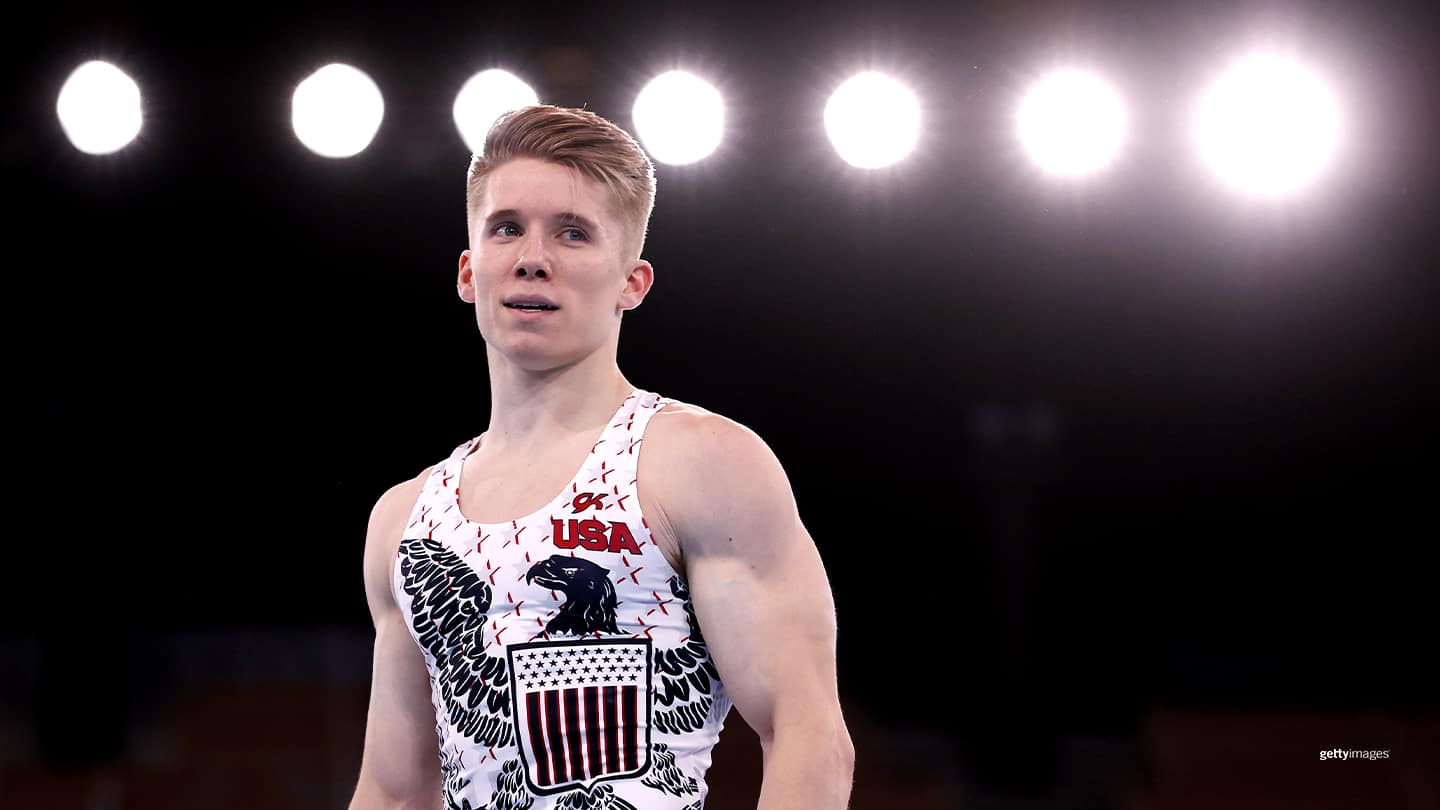
U.S. Men Qualify In Fourth For Gymnastics Team Finals
by Chrös McDougall

Shane Wiskus competing during day one of the Tokyo 2020 Olympic Games at Ariake Gymnastics Centre on July 24 in Tokyo, Japan.
TOKYO — Sam Mikulak’s feet settled into the mat, and then something funny happened.
At the Olympic Games Tokyo 2020, postponed one year due to the pandemic and held without fans due to rising COVID-19 case numbers in the Japanese capital, Team USA’s veteran men’s gymnast stuck his parallel bars routine — then a cheer went up on the opposite side of Ariake Gymnastics Centre.
As it turned out, a few dozen gymnasts and officials who weren’t taking part in the final men’s qualifying session Saturday had come to watch. Among them were Simone Biles and her teammates on the U.S. women’s team, who begin competition tomorrow. On a day when some local fans were also able to line the barriers at the men’s cycling road race in nearby Oyama, Japan, the cheers brought a small taste of the enthusiasm that was once expected to fill this intimate arena in Tokyo’s Ariake district.
“That felt so good,” said Mikulak, a two-time Olympian and the only American with previous Olympic experience. “It was nice. We created our own bubble, we had our own cheering section, it honestly felt like a normal competition in a way.”
Whether or not the cheers helped, the U.S. put together a balanced performance across the six rotations to finish fourth with 256.761 points and advance to Monday’s team finals, while also qualifying six spots in the individual event finals that take place in the following days.
Brody Malone (85.298) and Mikulak (84.664) qualified for the all-around finals on July 28 with the 11th and 14th best scores, respectively. Four gymnasts also qualified for apparatus finals on Aug. 1-3: Malone on high bar, Mikulak on parallel bars, Yul Moldauer on floor exercise and Alec Yoder on pommel horse. Shane Wiskus is the first alternate for floor finals.
In Olympic competition, gymnasts begin with a qualifying round to determine who moves on to event finals. In addition to the eight teams that qualify for Monday’s team finals, 24 advance to the all-around final while eight move on to each apparatus final. The caveat is only two per country can make an individual final.
Competing in the third and final subdivision on Saturday night, the Americans had their targets set, with favorites Japan, China and the Russian Olympic Committee having already gone.
Qualifying for the team final was essentially a given for the U.S., which has consistently been among the top-5 in the world in recent years. With just two major mistakes across the 24 routines, the U.S. edged Great Britain by .167 points for fourth place in qualifying. At the same time, the U.S. was more than five points behind the three favorites.
The Americans aren’t naive about what it would take to close that gap.
“A perfect meet,” Mikulak said with a laugh. “I think it would be a really flawless competition for us and a horrible competition for them. But you know, we’re just going to hope for the best in ourselves and wherever we land we’re going to be proud of the performances we put out there.”
Added Wiskus: “Honestly it takes off a lot of the pressure, actually, and helps us perform better, because we have nothing to lose at this point.”
Competing in a setting that felt more like podium training than the Olympics, the U.S. got the start it didn’t want when Moldauer came off the parallel bars in the team’s first routine. However, a powerful anchor set from Mikulak put things back on track, and with a monster score of 15.433 the seven-time U.S. champ finished fifth on the day, qualifying him for the finals in the ultra-competitive event.
Malone’s powerful swinging on high bar earned the Stanford gymnast and reigning NCAA champ a score of 14.533, good for fourth place on that event and a spot in the finals. Moldauer reached the floor exercise finals on the heels of his sturdy tumbling, qualifying in sixth with a score of 14.866. He is a 2017 world championships silver medalist on the event. If anyone in the floor finals is unable to compete, Wiskus, who finished ninth with 14.733 points, will replace them.
The emotional high for the team came in the fourth rotation.
Yoder, having qualified for the Olympics as an individual event specialist rather than part of the four-person team, had everything on the line in pommel horse. Make a mistake, and this routine would be his only one in Tokyo.
With his teammates on their feet beside the podium watching his every move, the former Ohio State star masterfully executed his movements around the apparatus. The roar from his teammates when Yoder’s feet hit the mat for a clean routine was as loud as any celebration all night.
With a score of 15.200, he had done his job. With the fourth best score, Yoder lives to fight another day.
“I’m surrounded by a bunch of great guys,” Yoder said.
By score, Moldauer and Wiskus also did well enough to qualify for the all-around finals, but they missed out due to the two-per country rule.
The U.S. men got eight entries into individual finals at the 2016 Olympics and came home with two silver medals and one bronze medal. That marked the top medal haul for the U.S. men since 2004, when they also won three medals, including team silver.
The last time the U.S. men reached the podium in the team competition was in 2008, when they finished third.
Want to follow Team USA athletes during the Olympic Games Tokyo 2020? Visit TeamUSA.org/Tokyo2020 to view the medal table, results and competition schedule.